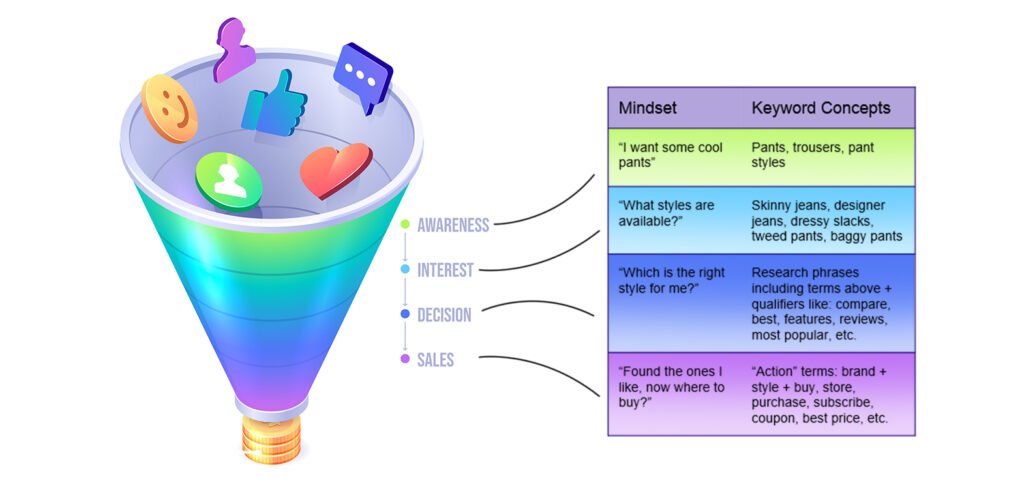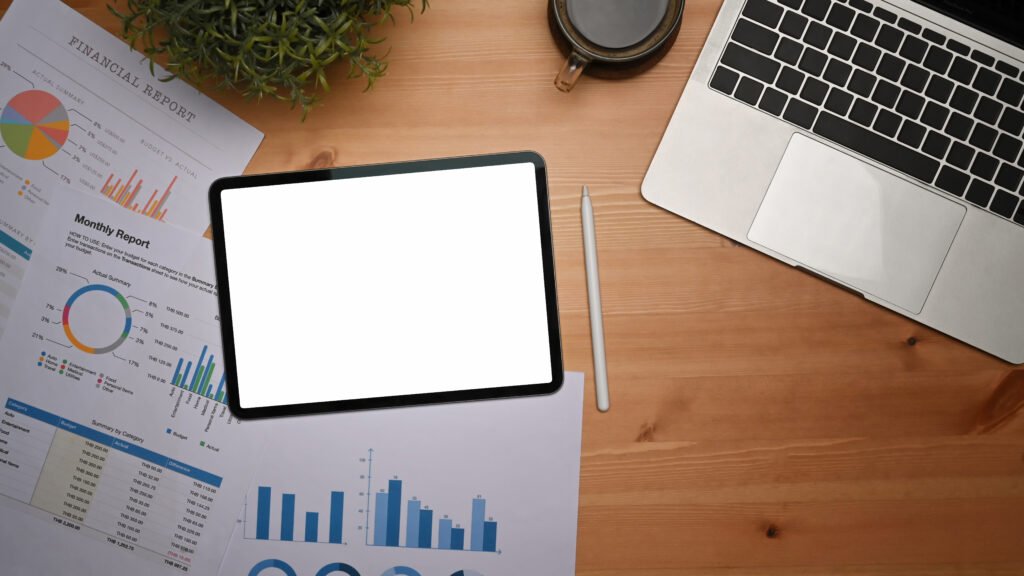Marketing consultancy brings countless benefits for companies to attract as many potential customers as possible, engage them, and eventually turn them into loyal customers. To achieve such, you must form a marketing funnel that effectively guides your potential customers through each stage of their journey.
Let’s look at the basic concept of a marketing funnel and the easiest way to create one for you.
What is a marketing funnel?
Marketing funnel, or the sales funnel or conversional funnel is a series of steps that potential customers go through before making a purchase. The funnel begins with awareness, where potential customers become aware of your product or service and then progresses through interest, decision, and action.
The Roadmap of this funnel marketing for your brand consists of paid ads, social media, SEO, Content marketing, and many other channels.
To optimize your marketing funnel for the customer journey, you, as the company, need to understand the customer’s mindset at each stage of the funnel. This will help you create a customized client experience by addressing their needs and concerns.
Understanding the Basic Marketing Funnel – AIDA
Funnel marketing has four main stages: awareness, interest, decision, and action. Each stage requires a different approach to engage and convert potential customers.
· Awareness: – Customers get to know about the brand, its products, or services for the first time through word-of-mouth, social media ads, and many others.
· Interest: – Interest is developed by the customer in products or services, and they try to find related information.
· Desire: – Possible customer develops the purchase intent and is near the decision-making stage.
· Action: – Customer takes action by purchasing the product.

Marketing funnel Stages
Funnel marketing is a traditional linear model used to grasp the knowledge about the customer journey. For companies, it is essential to recognize early that the funnel is not a straightforward path for the customers. Customers may enter the funnel at any stage during the purchase decision.
In fact, many customers may enter the funnel multiple times, jumping in and out at different stages before finally making a conversion. Others may make it all the way to the bottom of the funnel and then change their minds, dropping out at the last moment.
Customer journey funnel understanding is required from initial awareness to the final moment of conversion. It supports businesses in mapping their target audience and forming effective marketing strategies that convert customers towards conversion. However, you should be able to determine the value of full-funnel marketing, a one-size-fits-model for all. Here, we discuss the three marketing funnel stages.
Top of the funnel (TOFU): Awareness
Clients become aware of your brand and engage with products or services at this stage. The goal is to create brand awareness and grab the attention of the targeted audience. Customers who come across you should know more about the product.
To attain this, businesses can use diverse tactics such as search engine optimization (SEO), social media marketing, paid advertisement, and forming landing pages for generating awareness. Such tactics support improving online visibility, extending the reach to a targeted audience, and developing interest in the brand.
Middle of the funnel (MOFU): Consideration
The middle stage of the marketing funnel is a consideration, where customers consider whether they are likely to make the purchase of products or services. Companies aim to offer more knowledge about the products and keep the customers engaged.
To keep customers engaged with the brand, companies use some strategies like generating information about products or services through blog posts, videos, social media content, and email newsletters. Most customers look forward to the valuable information so that they can make the decision, and it becomes the brand’s duty to provide the required knowledge.

Bottom of the funnel (BOFU): Conversion
The bottom stage of marketing funnels is the decision or conversion stage. At this stage, possible clients decide to purchase and look for the best option. The ultimate goal of the stage is to convince the clients to convert.
To get a positive client conversion, businesses can use diverse tactics like offering clients reviews, testimonials as evidence, case studies to support the facts, and product demos. For a customer, conversion is possible with increased trust and confidence, which is possible with marketing.
Overall, understanding the three stages of funnel marketing is crucial for businesses that want to attract and convert potential customers. By using different tactics at each stage of the funnel, businesses can create a customized experience that addresses potential customers’ specific needs and concerns and helps them move through the funnel to purchase.
How to create marketing funnels for the brand?
Do you want to increase your customer retention and drive more sales for your business? Don’t you want to create funnel marketing for your brand? A well-optimized marketing funnel can do just that. By guiding your potential customers through each stage of their journey, you can create a seamless and enjoyable experience that increases loyalty and revenue.
Marketing funnel works in stages from the broader sector at the top that attracts people to the middle level and down to the narrower section at the bottom. By creating targeted content and activities for each stage, you can effectively reach and engage different people at different points in the buyer’s journey.
Let’s have a look at it.
Phase 1: Awareness Funnel
Prospects search for brand information on Google. Here, search engine optimization (SEO) plays a vital role in making the website accessible and visible to the users. Some of the actions that we’ll take to create a marketing funnel for your brand: –
· Create a landing page:- Landing page provides insight to the prospect to learn more about the business and its products and services. Share benefits of product or service.
· Keyword research:- Do use Keyword research software like Moz, SEMrush, or Ahrefs to find keywords of your niche. You should always use keywords with a search volume (>1000).
· Paid advertising campaigns:- Use Facebook and social media Ads to generate awareness among targeted audiences at a broader level. It’s a well-tried way to build a brand.

Phase 2: Consideration Funnel
The targeted audience considers your brand at this stage but wants to get the required details to make the final purchase. Trustworthy sources of information, what else the audience needs.
· Implement a search-focused content marketing strategy :- Here, you should create content around SEO-related topics and ensure to consider target keywords linked to topics like the top 10 digital marketing tools. It’s time to address the problems and questions of the audience.
· Forms of content:- You must be particular with the content you post. It can be “Long-Form Blog Articles,” “YouTube Videos,” and “Podcast Episodes.”
· Running giveaways and contests:- Offer giveaways, demo products or services to gain the attention of the customers and helps them to compare the products with others. Ensure to form a natural and logical link with customers; otherwise, it will affect brand value negatively.
Phase 3: Decision Funnel
Prospects make the final decision for a product or service. This stage is all about converting prospects into customers.
· Email marketing campaigns:- Email marketing campaigns and on-site surveys can be used. Send an email to users to fill their shopping cart with their wish list.
· Compare with others:- Comparative information should be given to access and understand different products for the final decision.
· Product reviews:- Product reviews are considered the best marketing content at this stage. It presents the features and benefits of products. For instance: “Apdetmize offers the best service in the category.”
· Case studies and testimonials: – Trust of the audience builds up based on the actual case studies and testimonials. Presenting such information will offer product information in detail.
How to measure the success of your marketing funnel?
Measuring the success of your marketing funnel is crucial for identifying areas of improvement and optimizing your marketing strategy. Here are some ways to measure the effectiveness of your funnels in marketing:
Customer lifetime value (LTV)
Customer lifetime value (LTV) measures the overall amount of money a client is likely to spend with a brand over their lifetime. Higher customer lifetime value means that there is an implementation of a successful marketing funnel. Motive is to predict the buyer’s intention to purchase a product or service.
Cost per acquisition (CPA)
Every business needs to look after its cost per acquisition to determine the spending on marketing to acquire each new customer. Customer acquisition funnel metrics should have a low cost for acquiring each new customer. Numbers are needed to evaluate paid advertising, email marketing, social media, and other paid marketing efforts. If the cost outweighs the gains, you might consider ending the campaign.
Conversion rates
Conversion rate measures the percentage of possible clients who take the required actions, such as making a purchase or filling out a lead form. You should keep track of conversion rates at every stage of the funnel to determine stages that require improvements. This funnel metric shows the conversion of customers to the final purchase of the product. Successful marketing funnel implementation leads to higher conversion rates.
Conversion rate per channel
Every marketing channel has been used to accomplish diverse goals, so an evaluation of the success of each channel is required.
· Organic search
· Influencers and referrals
· Paid ads (Social, SEM, and others)
Engagement funnel metrics
Brands should check the engagement level of their possible customers through click-through rates, time on site, and social media likes and shares can provide insight into how well your marketing content is resonating with your audience.
Return on investment (ROI)
ROI measures the amount of revenue generated from your marketing efforts compared to the cost of those efforts. A higher ROI indicates a more effective marketing funnel.
Time to conversion
This funnel metric measures the time it takes for a potential customer to move through the entire funnel and make a purchase. A shorter time to conversion indicates more effective funnels for marketing.
By tracking these metrics, you can better understand the effectiveness of your marketing funnel and make data-driven decisions to optimize your strategy.
Takeaways and next steps
Funnels of marketing are a critical tool for businesses looking to optimize their customer journey. Traditional marketing funnel says to convert more leads into paying customers and ultimately improve the business’s revenue.
The steps that the brand should follow to successfully implement funnels by the brand are well-explained. You can gain valuable insights into how your prospects interact with your brand by tracking funnel metrics such as customer acquisition cost, engagement metrics, and conversion rates.
It’s time to build a better funnel that speaks to your customer’s unique needs, ultimately driving more conversions and revenue for your business. We at Adeptimize support you to create successful marketing funnels that convert your goals to success.


